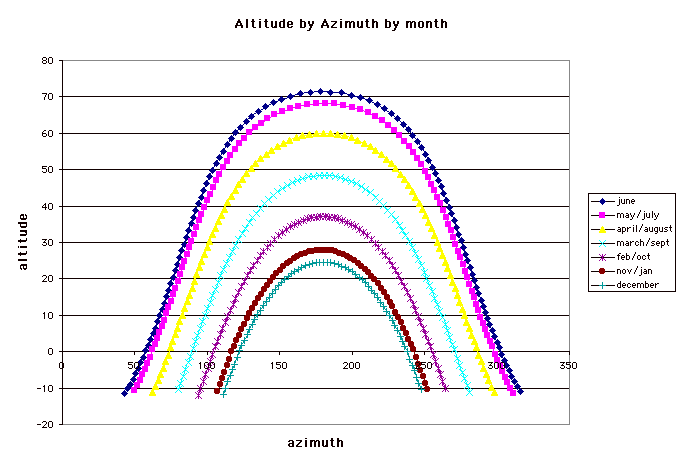
The altitude or elevation of the sun at noon varies as well, from 71 degrees at noon on the summer solstice to 24 degrees at noon on the winter solstice.
Perhaps the easiest way of seeing the combined effects of the seasons and time of day is to plot the solar altitude as a function of the solar azimuth as a family of curves, a different curve for each month.

Note also the number of hours of daylight varies from 15.3 in summer to 9.1 in winter.
The following table is organized from data provided by the US Naval Observatory
| date | Hours of Sunlight | Sunrise | Altitude | Sunset | Azimuth N of E/W |
|---|---|---|---|---|---|
| 21-Jun | 15.3 | 57 | 71 | 303 | 33 |
| 21-Jul | 14.8 | 61 | 68 | 299 | 29 |
| 21-Aug | 13.6 | 73 | 60 | 287 | 17 |
| 21-Sep | 12.1 | 90 | 47 | 270 | 0 |
| 21-Oct | 10.8 | 104 | 37 | 256 | -14 |
| 21-Nov | 9.6 | 117 | 28 | 243 | -27 |
| 21-Dec | 9.1 | 122 | 24 | 239 | -32 |
| 21-Jan | 9.6 | 117 | 28 | 243 | -27 |
| 21-Feb | 10.8 | 104 | 37 | 256 | -14 |
| 21-Mar | 12.1 | 90 | 47 | 270 | 0 |
| 21-Apr | 13.6 | 73 | 60 | 287 | 17 |
| 21-May | 14.8 | 61 | 68 | 299 | 29 |
| 21-Jun | 15.3 | 57 | 71 | 303 | 33 |

Azimuth can be converted from degrees (above) to deviations from East-West. That is, in summer there is a positive (Northerly) deviation, in the winter, a negative (Southerly) deviation.
